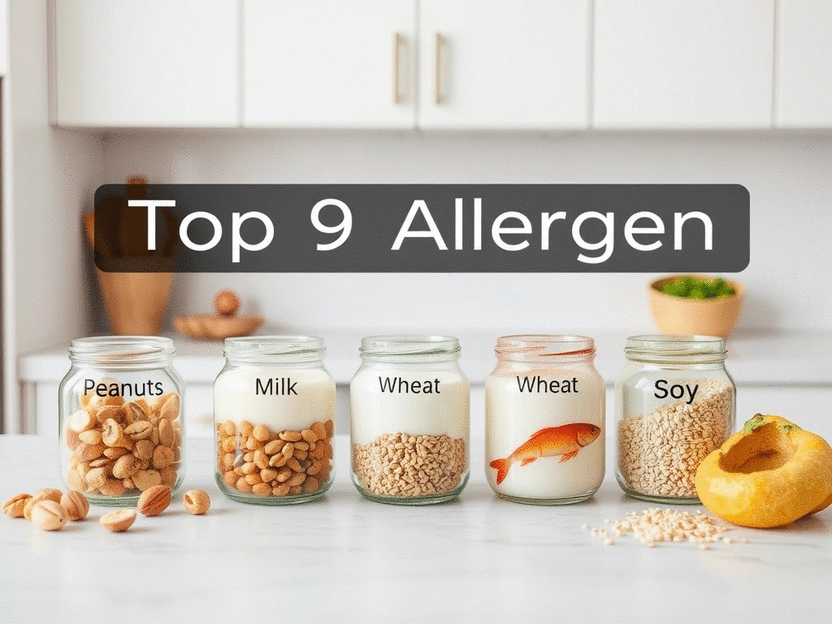Milk Allergy
Symptoms: Hives, stomach cramps, respiratory issues.
Sources: Cheese, yogurt, baked goods, processed foods.
Alternatives: Almond milk, coconut milk.
Food allergies affect millions, and understanding them can empower you to make safer dietary choices. With the right knowledge, you can navigate your meals confidently and ensure your safety while enjoying food.
This visual summarizes the top 9 food allergens, highlighting their common sources, typical symptoms, and safe alternatives. Understanding these details is crucial for effective allergy management.
Symptoms: Hives, stomach cramps, respiratory issues.
Sources: Cheese, yogurt, baked goods, processed foods.
Alternatives: Almond milk, coconut milk.
Symptoms: Skin reactions, gastrointestinal issues.
Sources: Baked goods, mayonnaise, dressings.
Alternatives: Applesauce, mashed bananas, flaxseed meal.
Symptoms: Severe reactions, anaphylaxis.
Sources: Peanut butter, trail mixes, snack bars.
Alternatives: Sunflower seed butter, soy nut butter.
Symptoms: Skin reactions, breathing problems.
Sources: Almonds, walnuts, cashews, nut oils.
Alternatives: Pumpkin seeds, sunflower seeds.
Symptoms: Mild irritation to severe reactions.
Sources: Fish sticks, seafood sauces, Asian dishes.
Alternatives: Chicken, plant-based proteins.
Symptoms: Hives, digestive distress.
Sources: Shrimp, crab, lobster.
Alternatives: Fish (consult allergist first).
Symptoms: Itching, swelling.
Sources: Tofu, soy sauce, processed foods.
Alternatives: Coconut aminos, homemade sauces.
Symptoms: Gastrointestinal issues, respiratory problems.
Sources: Breads, pasta, processed foods.
Alternatives: Rice, quinoa, gluten-free flours.
Symptoms: Mild to severe reactions.
Sources: Sesame seeds, oils, baked goods, Middle Eastern dishes.
Alternatives: Sunflower seeds.
When we talk about food allergens, we’re referring to certain foods that can trigger an immune response in some individuals. These reactions can range from mild to severe, and understanding them is crucial for anyone looking to maintain a healthy and safe diet. At What Are Allergies, we believe that knowledge is power when it comes to managing allergies effectively!
Food allergens are significant in dietary health because they can lead to various allergic reactions that affect your day-to-day life. From sneezing and itching to more severe symptoms like anaphylaxis, the impact is real. Therefore, knowing which foods to avoid and how to read labels can make a big difference in your overall well-being. For more comprehensive information on food allergies, you can visit the American College of Allergy, Asthma & Immunology (ACAAI) website.
Food allergens are specific proteins found in certain foods that can cause adverse reactions in sensitive individuals. These allergens trigger the immune system to overreact, leading to symptoms that can be uncomfortable or even life-threatening. Understanding food allergens is also essential because it allows individuals and families to make informed choices about their diets.
At What Are Allergies, we aim to provide you with comprehensive information on food allergens, empowering you to navigate your dietary needs with confidence. Let’s dive into the specifics of the top nine food allergens and what you need to know about each one!
A milk allergy occurs when your immune system reacts to proteins found in cow's milk. Common symptoms may include hives, stomach cramps, and even respiratory issues. It’s essential to be aware of foods where milk is a hidden ingredient, such as:
To avoid milk exposure, opt for alternatives like almond milk or coconut milk. Remember to always check labels and ask about ingredients when dining out!
Egg allergies are quite common, especially in children. Symptoms can range from skin reactions to severe gastrointestinal issues. Eggs are present in a variety of foods, including:
If you're dealing with an egg allergy, consider safe substitutes such as applesauce, mashed bananas, or flaxseed meal for baking. These alternatives can help maintain the texture of your dishes while keeping you safe!
Peanut allergies can provoke severe reactions, often requiring immediate medical attention. Symptoms may include skin reactions, digestive issues, or even anaphylaxis. Peanuts are commonly found in:
For those with peanut allergies, relying on sunflower seed butter or soy nut butter can be a delicious and safe alternative.
Tree nut allergies involve a reaction to nuts such as almonds, walnuts, and cashews. Symptoms may manifest in many ways, from skin reactions to breathing problems. You should avoid foods like:
Instead, consider seeds like pumpkin or sunflower seeds as a nutritious alternative, ensuring you steer clear of tree nuts!
Individuals with a fish allergy may experience symptoms ranging from mild irritation to severe reactions. Fish is commonly found in:
Safe alternatives could include chicken or plant-based proteins, allowing you to enjoy meals without the risk.
A shellfish allergy encompasses a reaction to crustaceans and mollusks, leading to symptoms like hives or digestive distress. Common sources include:
Fish is typically safe for those with shellfish allergies, but always consult with your allergist before trying new foods.
Soy allergies are less common but can lead to serious reactions. Symptoms may include itching or swelling. Soy is often found in:
For safe options, consider coconut aminos or homemade sauces to substitute soy products while cooking!
Wheat allergies can cause various symptoms, such as gastrointestinal issues or respiratory problems. It’s vital to distinguish it from celiac disease, which is an autoimmune disorder. Common sources of wheat include:
Safe alternatives can be found in gluten-free grains like rice, quinoa, or gluten-free flours!
Recently, sesame has been recognized as a significant allergen, leading to new labeling requirements. Symptoms can range from mild to severe. Common sources include:
Always check labels, as sesame is often included in unexpected products. Consider using alternatives like sunflower seeds for flavor!
Recognizing food allergies is essential for effective management. Symptoms can vary widely and often emerge shortly after consuming the allergenic food. If you suspect food allergies, consulting a healthcare professional for proper testing and diagnosis is crucial. The Centers for Disease Control and Prevention (CDC) provides valuable resources on managing food allergies, especially in school settings.
Food labeling laws, like the Food Allergen Labeling and Consumer Protection Act (FALCPA) and the recent FASTER Act, play a vital role in ensuring safety for individuals with food allergies. These regulations mandate clear labeling, helping consumers identify allergens quickly and make safer choices. The FDA website offers detailed information on these labeling requirements.
Having an emergency action plan is critical for individuals with severe allergies. Carrying an EpiPen and knowing when to use it can save lives during an anaphylactic reaction. Always communicate your allergy status to friends and family!
At home and in social settings, preventing cross-contact is essential. Here are some practical tips:
Implementing these strategies can significantly reduce the risk of accidental exposure.
Managing food allergies in restaurants, schools, and gatherings can be daunting. Here are strategies to help:
By being proactive, you can enjoy social situations while keeping your allergies in check!
Cooking at home is a great way to ensure your meals are safe. Here are some best practices:
With careful preparation, you can enjoy delicious meals that fit your dietary needs!
Building a supportive community is vital for those with food allergies. Seek resources from local support groups, online forums, and educational platforms like What Are Allergies. Sharing experiences can provide comfort and valuable insights!
When dining out, always communicate your food allergies clearly to the staff. Consider carrying a card that lists your allergies and safe foods to ensure there’s no misunderstanding. This simple step can help you enjoy your meal with peace of mind!
Understanding food allergens is crucial for anyone looking to navigate dietary restrictions effectively. We've explored the top nine allergens that affect many individuals and families. To manage these allergies safely, it’s essential to adopt effective avoidance strategies. Remember, knowledge is power, and being informed can significantly improve your quality of life.
By recognizing symptoms, understanding ingredient sources, and implementing safe substitutions, we can create a more manageable and enjoyable eating experience. So, let’s dive into some key takeaways!
One of the most important steps in managing food allergies is to consult with healthcare professionals. Allergists or dietitians can provide personalized management plans tailored to your specific needs. They can help you identify triggers, suggest safe alternatives, and offer practical advice on navigating food-related challenges.
Working closely with a professional can build your confidence in making safe food choices!
Staying informed about food allergies is essential for effective management. There are many resources available that can help you understand the complexities of allergies and food safety. Websites like FARE (Food Allergy Research & Education) and the FDA offer up-to-date information on allergens, labeling laws, and safe eating practices.
By utilizing these resources, you’ll be empowered to make informed decisions regarding your dietary health!
Now that you’re equipped with essential information about food allergens, it’s time to create your personalized action plan. Assess your current dietary habits and make note of any potential allergens in your meals. Implement safe substitutions based on what you’ve learned to protect yourself and enjoy a wider variety of foods.
Taking these proactive steps can lead to greater peace of mind as you navigate your food choices.
It’s also important to distinguish between food allergies and food intolerances. While both can cause discomfort, they differ significantly in symptoms and management strategies. Food allergies involve an immune response, which can lead to serious reactions, while intolerances typically involve digestive issues.
By understanding these differences, you can better navigate your dietary needs and communicate effectively with healthcare providers!
Here is a quick recap of the important points discussed in the article:


